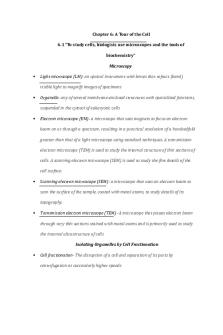Chapter 6 Outline - Summary Campbell Biology PDF

| Title | Chapter 6 Outline - Summary Campbell Biology |
|---|---|
| Course | Introduction to Biology A |
| Institution | University of Pennsylvania |
| Pages | 4 |
| File Size | 73 KB |
| File Type | |
| Total Downloads | 54 |
| Total Views | 162 |
Summary
Outline...
Description
Chapter 6: A Tour of the Cell 6.1 “To study cells, biologists use microscopes and the tools of biochemistry” Microscopy
In light microscopes (LM) visible light is passed through the specimen and then through glass lenses. Then lenses refract the light in such a way that the image is magnified
Magnification is the ratio of an object’s image size to its real size. Resolution is a measure of the clarity of the image
Most organelles are too small to be seen by the LM
Electron microscope focuses a beam of electrons through the specimen or onto its surface. It can achieve a resolution of 0.002. Biologists use the term ultrastructure to refer to a cell’s anatomy as revealed by an EM
There are two types of EMs: scanning electron microscope (SEM) and transmission electron microscope (TEM) Isolating Organelles by Cell Fractionation
The goal of cell fractionation is to take cells apart and separate the major organelles from one another. The instrument used is the centrifuge. Ultracentrifuges are the most powerful, spinning as fast as 130,000 revolutions per minute (RPM) 6.2 “Eukaryotic cells have internal membranes that compartmentalize their functions”
Organelles are found in cytosol
The entire region between the nucleus and plasma membrane is called the cytoplasm
The plasma membrane functions as a selective barrier that allows sufficient passage of oxygen, nutrients, and wastes to service the entire volume of the cell 6.3 “The eukaryotic cell’s genetic instructions are housed in the nucleus and carried out by the ribosomes” The Nucleus: Genetic Library of the Cell
The nucleus contains most of the genes in the eukaryotic cell. The nuclear envelope encloses the nucleus, separating its contents from the cytoplasm
The nuclear side of the envelope is lined by the nuclear lamina, except at the pores
DNA is organized into discrete units called chromosomes, structures that carry the genetic information within the nucleus
Each chromosome is made up of a material called chromatin, a complex of proteins and DNA
A prominent structure within the nondividing nucleus is the nucleolus Ribosomes: Protein Factories in the Cell
Ribosomes are particles made of ribosome RNA and protein. They are the organelles that carry out protein synthesis 6.4 “The endomembrane system regulates protein traffic and performs metabolic functions in the cell”
Endomembrane system carries out a variety of tasks in the cell
The membranes of this system are related through physical continuity or by the transfer of membrane segments as tiny vesicles
The system includes the nuclear envelope, endoplasmic reticulum, Golgi apparatus, lysosomes, various kinds of vacuoles, and plasma membrane The Endoplasmic Reticulum: Biosynthetic Factory
The ER consists of a network of membranous tubules and sacs called cisternae
There are two types of ER: smooth ER and rough ER The Golgi Apparatus: Shipping and Receiving Center
In the GA, products of ER are modified and stored and then sent to other destinations Lysosomes
A lysosome is a membranous sac of hydrolytic enzymes that an animal cell uses to digest all kinds of macromolecules
Phagocytosis is a process by which protists ear by engulfing smaller organisms or other food particles Vacuoles: Diverse Maintenance Compartments
Food vacuoles are formed by phagocytosis. Contractile vacuoles pump excess water out of the cell.
Mature plant cells contain a large central vacuole enclosed by a membrane called the tonoplast 6.5 “Mitochondria and chloroplasts change energy from one form to another”
Mitochondria are the sites of cellular respiration, the metabolic process that generates ATP by extracting energy from sugars, fats, and other fuels with the help of oxygen
Chloroplasts are the sites of photosynthesis 6.6 “The cytoskeleton is a network of fibers that organizes structures and activities in the cell”
The cytoskeleton is a network of fibers extending through out the cytoplasm
The roles of the cytoskeleton is support, motility, and regulation
The three fibers that makeup cytoskeleton are microtubules (thickest), microfilaments (AKA actin filaments) are the thinnest, and intermediate filaments are fibers with diameters in the middle range 6.7 “Extracellular components and connections between cells help coordinate cellular activities” Cell Walls of Plants
The cell wall is an extracellular structure of plants cells that distinguishes them form animal cells. It protects the cell, maintains its shape, and prevents excessive uptake of water The Extracellular Matrix (ECM) of Animal Cells
The main ingredients of the ECM are glycoproteins secrete by the cells. The most abundant glycoprotein is the collagen Intercellular Junctions
Plants cell walls are perforated with channels called plasmodesmata...
Similar Free PDFs
Popular Institutions
- Tinajero National High School - Annex
- Politeknik Caltex Riau
- Yokohama City University
- SGT University
- University of Al-Qadisiyah
- Divine Word College of Vigan
- Techniek College Rotterdam
- Universidade de Santiago
- Universiti Teknologi MARA Cawangan Johor Kampus Pasir Gudang
- Poltekkes Kemenkes Yogyakarta
- Baguio City National High School
- Colegio san marcos
- preparatoria uno
- Centro de Bachillerato Tecnológico Industrial y de Servicios No. 107
- Dalian Maritime University
- Quang Trung Secondary School
- Colegio Tecnológico en Informática
- Corporación Regional de Educación Superior
- Grupo CEDVA
- Dar Al Uloom University
- Centro de Estudios Preuniversitarios de la Universidad Nacional de Ingeniería
- 上智大学
- Aakash International School, Nuna Majara
- San Felipe Neri Catholic School
- Kang Chiao International School - New Taipei City
- Misamis Occidental National High School
- Institución Educativa Escuela Normal Juan Ladrilleros
- Kolehiyo ng Pantukan
- Batanes State College
- Instituto Continental
- Sekolah Menengah Kejuruan Kesehatan Kaltara (Tarakan)
- Colegio de La Inmaculada Concepcion - Cebu















